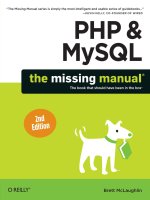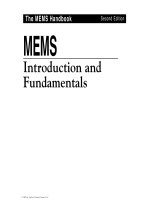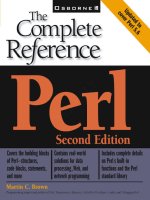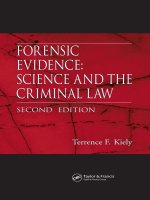Quarks leptons and the big bang second edition
Bạn đang xem bản rút gọn của tài liệu. Xem và tải ngay bản đầy đủ của tài liệu tại đây (3.6 MB, 440 trang )
Quarks, Leptons and
the Big Bang
Second Edition
Quarks, Leptons and
the Big Bang
Second Edition
Jonathan Allday
The King’s School, Canterbury
Institute of Physics Publishing
Bristol and Philadelphia
c IOP Publishing Ltd 2002
All rights reserved. No part of this publication may be reproduced,
stored in a retrieval system or transmitted in any form or by any means,
electronic, mechanical, photocopying, recording or otherwise, without
the prior permission of the publisher. Multiple copying is permitted in
accordance with the terms of licences issued by the Copyright Licensing
Agency under the terms of its agreement with the Committee of ViceChancellors and Principals.
British Library Cataloguing-in-Publication Data
A catalogue record for this book is available from the British Library.
ISBN 0 7503 0806 0
Library of Congress Cataloging-in-Publication Data are available
First edition printed 1998
First edition reprinted with minor corrections 1999
Commissioning Editor: James Revill
Production Editor: Simon Laurenson
Production Control: Sarah Plenty
Cover Design: Fr´ed´erique Swist
Marketing Executive: Laura Serratrice
Published by Institute of Physics Publishing, wholly owned by The
Institute of Physics, London
Institute of Physics Publishing, Dirac House, Temple Back, Bristol BS1
6BE, UK
US Office: Institute of Physics Publishing, The Public Ledger Building,
Suite 1035, 150 South Independence Mall West, Philadelphia, PA 19106,
USA
Typeset in LATEX 2ε by Text 2 Text, Torquay, Devon
Printed in the UK by MPG Books Ltd, Bodmin, Cornwall
Contents
Preface to the second edition
ix
Preface to the first edition
xiii
Prelude: Setting the scene
1
1
The standard model
1.1 The fundamental particles of matter
1.2 The four fundamental forces
1.3 The big bang
1.4 Summary of chapter 1
5
5
10
14
18
2
Aspects of the theory of relativity
2.1 Momentum
2.2 Kinetic energy
2.3 Energy
2.4 Energy and mass
2.5 Reactions and decays
2.6 Summary of chapter 2
21
21
28
31
32
37
40
3
Quantum theory
3.1 The double slot experiment for electrons
3.2 What does it all mean?
3.3 Feynman’s picture
3.4 A second experiment
3.5 How to calculate with amplitudes
3.6 Following amplitudes along paths
3.7 Amplitudes, states and uncertainties
3.8 Summary of chapter 3
42
44
49
50
53
56
59
72
82
vi
Contents
4
The leptons
4.1 A spotter’s guide to the leptons
4.2 The physical properties of the leptons
4.3 Neutrino reactions with matter
4.4 Some more reactions involving neutrinos
4.5 ‘Who ordered that?’
4.6 Solar neutrinos again
4.7 Summary of chapter 4
85
85
87
89
93
95
98
99
5
Antimatter
5.1 Internal properties
5.2 Positrons and mystery neutrinos
5.3 Antiquarks
5.4 The general nature of antimatter
5.5 Annihilation reactions
5.6 Summary of chapter 5
101
101
107
110
112
114
116
6
Hadrons
6.1 The properties of the quarks
6.2 A review of the strong force
6.3 Baryons and mesons
6.4 Baryon families
6.5 Meson families
6.6 Internal properties of particles
6.7 Summary of chapter 6
118
118
122
123
124
129
131
132
7
Hadron reactions
7.1 Basic ideas
7.2 Basic processes
7.3 Using conservation laws
7.4 The physics of hadron reactions
7.5 Summary of chapter 7
134
134
135
140
142
147
8
Particle decays
8.1 The emission of light by atoms
8.2 Baryon decay
8.3 Meson decays
8.4 Strangeness
8.5 Lepton decays
8.6 Summary of chapter 8
148
148
149
162
164
165
166
9
The evidence for quarks
9.1 The theoretical idea
167
167
Contents
9.2
9.3
9.4
9.5
Deep inelastic scattering
Jets
The November revolution
Summary of chapter 9
10 Experimental techniques
10.1 Basic ideas
10.2 Accelerators
10.3 Targets
10.4 Detectors
10.5 A case study—DELPHI
10.6 Summary of chapter 10
Interlude 1: CERN
11 Exchange forces
11.1 The modern approach to forces
11.2 Extending the idea
11.3 Quantum field theories
11.4 Grand unification
11.5 Exotic theories
11.6 Final thoughts
11.7 Summary of chapter 11
Interlude 2: Antihydrogen
vii
167
173
178
179
181
181
182
188
190
197
201
203
210
210
217
222
234
236
237
238
241
12 The big bang
12.1 Evidence
12.2 Explaining the evidence
12.3 Summary of chapter 12
244
244
251
265
13 The geometry of space
13.1 General relativity and gravity
13.2 Geometry
13.3 The geometry of the universe
13.4 The nature of gravity
13.5 The future of the universe?
13.6 Summary
267
267
269
272
276
279
281
14 Dark matter
14.1 The baryonic matter in the universe
14.2 The evidence for dark matter
14.3 What is the dark matter?
14.4 Summary of chapter 14
284
284
286
298
315
viii
Contents
Interlude 3: A brief history of cosmology
15 Inflation—a cure for all ills
15.1 Problems with the big bang theory
15.2 Inflation
15.3 The return of
15.4 The last word on galaxy formation
15.5 Quantum cosmology
15.6 The last word
15.7 Summary of chapter 15
319
326
326
334
357
366
368
370
370
Postlude: Philosophical thoughts
374
Appendix 1: Nobel Prizes in physics
378
Appendix 2: Glossary
386
Appendix 3: Particle data tables
403
Appendix 4: Further reading
408
Index
413
Preface to the second edition
It is surely a truism that if you wrote a book twice, you would not do it
the same way the second time. In my case, Quarks, Leptons and the Big
Bang was hauled round several publishers under the guise of a textbook
for schools in England. All the time I knew that I really wanted it to
be a popular exposition of particle physics and the big bang, but did not
think that publishers would take a risk on such a book from an unknown
author. Well, they were not too keen on taking a risk with a textbook
either. In the end I decided to send it to IOPP as a last try. Fortunately
Jim Revill contacted me to say that he liked the book, but thought it
should be more of a popular exposition than a textbook. . .
This goes some way to explaining what some have seen as slightly odd
omissions from the material in this book—some mention of superstrings
as one example. Such material was not needed in schools and so did not
make it into the book. However, now that we are producing a second
edition there is a chance to correct that and make it a little more like it
was originally intended to be.
I am very pleased to say that the first edition has been well received.
Reviewers have been kind, sales have been satisfying and there have
been many emails from people saying how much they enjoyed the book.
Sixth form students have written to say they like it, a University of the
Third Age adopted it as a course book and several people have written
to ask me further questions (which I tried to answer as best I could). It
has been fun to have my students come up to me from time to time to
say that they have found one of my books on the Amazon web site and
(slightly surprised tone of voice) the reviewers seem to like it.
ix
x
Preface to the second edition
Well here goes with a second edition. As far as particle physics is
concerned nothing has changed fundamentally since the first edition was
published. I have taken the opportunity to add some material on field
theory and to tweak the chapters on forces and quantum theory. The
information on what is going on at CERN has been brought more up to
date including some comment on the Higgs ‘discovery’ at CERN. There
are major revisions to the cosmology sections that give more balance to
the two aspects of the book. In the first edition cosmology was dealt
with in two chapters; now it has grown to chapters 12, 13, 14 and 15.
The new chapter 13 introduces general relativity in far more detail and
bolsters the coverage of how it applies to cosmology. The evidence for
dark matter has been pulled together into chapter 14 and brought more up
to date by adding material on gravitational lensing. Inflation is dealt with
in chapter 15. Experimental support for inflation has grown and there is
now strong evidence to suggest that Einstein’s cosmological constant is
going to have to be dusted off. All this is covered in the final chapter of
the book.
There are some quite exciting times ahead for cosmologists as the results
of new experiments probing the background radiation start to come
in over the next few years. Probably something really important will
happen just after the book hits the shelves.
Then there will have to be a third edition. . .
Preface to the second edition
xi
Further thanks
Carlos S Frenk
(University of Durham) who spent some of his
valuable time reading the cosmology sections of the
first edition and then helping me bring them up to
date.
Andrew Liddle
(University of Sussex) for help with certain aspects
of inflationary theory.
Jim Revill
For continual support and encouragement at IOPP.
Simon Laurenson
Continuing the fine production work at IOPP.
Carolyn Allday
Top of the ‘without whom’ list.
Toby Allday
Another possible computer burner who held off.
Jonathan Allday
Sunday, April 15, 2001
Preface to the first edition
It is difficult to know what to say in the preface to a book. Certainly it
should describe what the book is about.
This is a book about particle physics (the strange world of objects and
forces that exists at length scales much smaller than the size of an atom)
and cosmology (the study of the origin of the universe). It is quite
extraordinary that these two extremes of scale can be drawn together
in one book. Yet the advances of the past couple of decades have shown
that there is an intimate relationship between the world of the very large
and the very small. The key moment that started the forging of this
relationship was the discovery of the expansion of the universe in the
1920s. If the universe has been expanding since its creation (some 15
billion years ago) then at some time in the past the objects within it were
very close together and interacting by the forces that particle physicists
study. At one stage in its history the whole universe was the microscopic
world. In this book I intend to take the reader on a detailed tour of the
microscopic world and then through to the established ideas about the
big bang creation of the universe and finally to some of the more recent
refinements and problems that have arisen in cosmology. In order to do
this we need to discuss the two most important fundamental theories that
have been developed this century: relativity and quantum mechanics.
The treatment is more technical than a popular book on the subject, but
much less technical than a textbook.
Another thing that a preface should do is to explain what the reader is
expected to know in advance of starting this book.
xiii
xiv
Preface to the first edition
In this book I have assumed that the reader has some familiarity with
energy, momentum and force at about the level expected of a modern
GCSE candidate. I have also assumed a degree of familiarity with
mathematics—again at about the modern GCSE level. However, readers
who are put off by mathematics can always leave the boxed calculations
for another time without disturbing the thread of the argument.
Finally, I guess that the preface should give some clue as to the spirit
behind the book. In his book The Tao of Physics Fritjof Capra says that
physics is a ‘path with a heart’. By this he means that it is a way of
thinking that can lead to some degree of enlightenment not just about
the world in which we live, but also about us, the people who live in
it. Physics is a human subject, despite the dry mathematics and formal
presentation. It is full of life, human tragedy, exhilaration, wonder and
very hard work. Yet by and large these are not words that most people
would associate with physics after being exposed to it at school (aside
from hard work that is). Increasingly physics is being marginalized
as an interest at the same time as it is coming to grips with the most
fundamental questions of existence. I hope that some impression of the
life behind the subject comes through in this book.
Acknowledgments
I have many people to thank for their help and support during the writing
of this book.
Liz Swinbank, Susan Oldcorn and Lewis Ryder for their sympathetic
reading of the book, comments on it and encouragement that I was on
the right lines.
Professors Brian Foster and Ian Aitchison for their incredibly detailed
readings that found mistakes and vagaries in the original manuscript.
Thanks to them it is a much better book. Of course any remaining
mistakes can only be my responsibility.
Jim Revill, Al Troyano and the production team at Institute of Physics
Publishing.
Preface to the first edition
xv
Many students of mine (too many to list) who have read parts of the book.
Various Open University students who have been a source of inspiration
over the years and a captive audience when ideas that ended up in this
book have been put to the test at summer schools.
Graham Farmello, Gareth Jones, Paul Birchley, David Hartley and Becky
Parker who worked with Liz and I to spice up A level physics by putting
particle physics in.
Finally thanks to family and friends.
Carolyn, Benjamin and Joshua who have been incredibly patient with
me and never threatened to set fire to the computer.
My parents Joan and Frank who knew that this was something that I
really wanted to do.
John and Margaret Gearey for welcoming me in.
Robert James, a very close friend for a very long time.
Richard Houlbrook, you see I said that I would not forget you.
Jonathan Allday
November 1997
Prelude
Setting the scene
What is particle physics?
Particle physics attempts to answer some of the most basic questions
about the universe:
•
•
•
are there a small number of different types of objects from which
the universe is made?
do these objects interact with each other and, if so, are there some
simple rules that explain what will happen?
how can we study the creation of the universe in a laboratory?
The topics that particle physicists study from one day to the next have
changed as the subject has progressed, but behind this progression the
final goal has remained the same—to try to understand how the universe
came into being.
Particle physics tries to answer questions about the origin of our universe
by studying the objects that are found in it and the ways in which they
interact. This is like someone trying to learn how to play chess by
studying the shapes of the pieces and the ways in which they move across
the board.
Perhaps you think that this is a strange way to try to find out about the
origin of the universe. Unfortunately, there is no other way. There are
instruction manuals to help you learn how to play chess; there are no
instruction manuals supplied with the universe. Despite this handicap an
impressive amount has been understood by following this method.
1
2
Setting the scene
Some people argue that particle physics is fundamental to all the sciences
as it strips away the layers of structure that we see in the world and
plunges down to the smallest components of matter. This study applies
equally to the matter that we see on the earth and that which is in the stars
and galaxies that fill the whole universe. The particle physicist assumes
that all matter in the universe is fundamentally the same and that it all
had a common origin in the big bang that created our universe. (This
is a reasonable assumption as we have no evidence to suggest that any
region of the universe is made of a different form of matter. Indeed we
have positive evidence to suggest the opposite.)
The currently accepted scientific theory is that our universe came into
being some fifteen billion years ago in a gigantic explosion. Since
then it has been continually growing and cooling down. The matter
created in this explosion was subjected to unimaginable temperatures
and pressures. As a result of these extreme conditions, reactions took
place that were crucial in determining how the universe would turn out.
The structure of the universe that we see now was determined just after
its creation.
If this is so, then the way that matter is structured now must reflect
this common creation. Hence by building enormous and expensive
accelerating machines and using them to smash particles together at
very high energies, particle physicists can force the basic constituents of
matter into situations that were common in the creation of the universe—
they produce miniature big bangs. Hardly surprisingly, matter can
behave in very strange ways under these circumstances.
Of course, this programme was not worked out in advance. Particle
physics was being studied before the big bang theory became generally
accepted. However, it did not take long before particle physicists realized
that the reactions they were seeing in their accelerators must have been
quite common in the early universe. Such experiments are now providing
useful information for physicists working on theories of how the universe
was created.
In the past twenty years this merging of subjects has helped some huge
leaps of understanding to take place. We believe that we have an
accurate understanding of the evolution of the universe from the first
10−5 seconds onwards (and a pretty good idea of what happened even
Setting the scene
3
earlier). By the time you have finished this book, you will have met
many of the basic ideas involved.
Why study particle physics?
All of us, at some time, have paused to wonder at our existence. As
children we asked our parents embarrassing questions about where we
came from (and, in retrospect, probably received some embarrassing
answers). In later years we may ask this question in a more mature
form, either in accepting or rejecting some form of religion. Scientists
that dedicate themselves to pure research have never stopped asking this
question.
It is easy to conclude that society does not value such people. Locking
oneself away in an academic environment ‘not connected with the real
world’ is generally regarded as a (poorly paid) eccentricity. This is very
ironic. Scientists are engaged in studying a world far more real than the
abstract shuffling of money on the financial markets. Unfortunately, the
creation of wealth and the creation of knowledge do not rank equally in
the minds of most people.
Against this background of poor financial and social status it is a wonder
that anyone chooses to follow the pure sciences; their motivation must
be quite strong. In fact, the basic motivation is remarkably simple.
Everyone has, at some time, experienced the inner glow that comes from
solving a puzzle. This can take many forms, such as maintaining a car,
producing a difficult recipe, solving a jigsaw puzzle, etc. Scientists are
people for whom this feeling is highly magnified. Partly this is because
they are up against the ultimate puzzle. As a practising and unrepentant
physicist I can testify to the feeling that comes from prising open the door
of nature by even a small crack and understanding something new for the
first time. When such an understanding is achieved the feeling is one of
personal satisfaction, but also an admiration for the puzzle itself. Few of
us are privileged enough to get a glimpse through a half-open door, like
an Einstein or a Hawking, but we can all look over their shoulders. The
works of the truly great scientists are part of our culture and should be
treated like any great artistic creation. Such work demands the support
of society.
4
Setting the scene
Unfortunately, the appreciation of such work often requires a high degree
of technical understanding. This is why science is not valued as much
as it might be. The results of scientific experiments are often felt to be
beyond the understanding, and hence the interest, of ordinary people.
Scientists are to blame. When Archimedes jumped out of his bath and
ran through the streets shouting ‘Eureka!’ he did not stop to explain
his actions to the passers by. Little has changed in this respect over the
intervening centuries. We occasionally glimpse a scientist running past
shouting about some discovery, but are unable to piece anything together
from the fragments that we hear. Few scientists are any good at telling
stories.
The greatest story that can be told is the story of creation. In the past
few decades we have been given an outline of the plot, and perhaps a
glimpse of the last page. As in all mystery stories the answer seems so
obvious and simple, it is a wonder that we did not think of it earlier. This
is a story so profound and wonderful that it must grab the attention of
anyone prepared to give it a moment’s time.
Once it has grabbed you, questions as to why we should study such
things become irrelevant—it is obvious that we must.
Chapter 1
The standard model
This chapter is a brief summary of the theories discussed in
the rest of this book. The standard model of particle physics—
the current state of knowledge about the structure of matter—
is described and an introduction provided to the ‘big bang’
theory of how the universe was created. We shall spend the
rest of the book exploring in detail the ideas presented in this
chapter.
1.1 The fundamental particles of matter
It is remarkable that a list of the fundamental constituents of matter easily
fits on a single piece of paper. It is as if all the recipes of all the chefs
that have been and will be could be reduced to combinations of twelve
simple ingredients.
The twelve particles from which all forms of matter are made are listed
in table 1.1. Twelve particles, that is all that there is to the world of
matter.
The twelve particles are divided into two distinct groups called the
quarks and the leptons (at this stage don’t worry about where the names
come from). Quarks and leptons are distinguished by the different ways
in which they react to the fundamental forces.
There are six quarks and six leptons. The six quarks are called up, down,
strange, charm, bottom and top1 (in order of mass). The six leptons are
5
6
The standard model
Table 1.1. The fundamental particles of matter.
Quarks
up
down
strange
charm
bottom
top
Leptons
(u)
(d)
(s)
(c)
(b)
(t)
electron
electron-neutrino
muon
muon-neutrino
tau
tau-neutrino
(e− )
(νe )
(µ− )
(νµ )
(τ − )
(ντ )
the electron, the electron-neutrino, the muon, muon-neutrino, tau and
tau-neutrino. As their names suggest, their properties are linked.
Already in this table there is one familiar thing and one surprise.
The familiar thing is the electron, which is one of the constituents of
the atom and the particle that is responsible for the electric current in
wires. Electrons are fundamental particles, which means that they are not
composed of any smaller particles—they do not have any pieces inside
them. All twelve particles in table 1.1 are thought to be fundamental—
they are all distinct and there are no pieces within them.
The surprise is that the proton and the neutron are not mentioned in the
table. All matter is composed of atoms of which there are 92 naturally
occurring types. Every atom is constructed from electrons which orbit
round a small, heavy, positively charged nucleus. In turn the nucleus is
composed of protons, which have a positive charge, and neutrons, which
are uncharged. As the size of the charge on the proton is the same as
that on the electron (but opposite in sign), a neutral atom will contain the
same number of protons in its nucleus as it has electrons in its orbit. The
numbers of neutrons that go with the protons can vary by a little, giving
the different isotopes of the atom.
However, the story does not stop at this point. Just as we once believed
that the atom was fundamental and then discovered that it is composed
of protons, neutrons and electrons, we now know that the protons and
neutrons are not fundamental either (but the electron is, remember).
Protons and neutrons are composed of quarks.
The fundamental particles of matter
7
Specifically, the proton is composed of two up quarks and one down
quark. The neutron is composed of two down quarks and one up quark.
Symbolically we can write this in the following way:
p ≡ uud
n ≡ udd.
As the proton carries an electrical charge, at least some of the quarks
must also be charged. However, similar quarks exist inside the neutron,
which is uncharged. Consequently the charges of the quarks must add
up in the combination that composes the proton but cancel out in the
combination that composes the neutron. Calling the charge on an up
quark Qu and the charge on a down quark Qd , we have:
p (uud) charge = Qu + Qu + Qd = 1
n (udd) charge = Qu + Qd + Qd = 0.
Notice that in these relationships we are using a convention that sets the
charge on the proton equal to +1. In standard units this charge would be
approximately 1.6 × 10−19 coulombs. Particle physicists normally use
this abbreviated unit and understand that they are working in multiples
of the proton charge (the proton charge is often written as +e).
These two equations are simple to solve, producing:
Qu = charge on the up quark = + 23
Qd = charge on the down quark = − 13 .
Until the discovery of quarks, physicists thought that electrical charge
could only be found in multiples of the proton charge. The standard
model suggests that there are three basic quantities of charge: +2/3,
−1/3 and −1.2
The other quarks also have charges of +2/3 or −1/3. Table 1.2 shows
the standard way in which the quarks are grouped into families. All the
quarks in the top row have charge +2/3, and all those in the bottom row
have charge −1/3. Each column is referred to as a generation. The up
and down quarks are in the first generation; the top and bottom quarks
belong to the third generation.
8
The standard model
Table 1.2. The grouping of quarks into generations (NB: the letters in brackets
are the standard abbreviations for the names of the quarks).
+2/3
−1/3
1st generation
2nd generation
3rd generation
up (u)
down (d)
charm (c)
strange (s)
top (t)
bottom (b)
This grouping of quarks into generations roughly follows the order in
which they were discovered, but it has more to do with the way in which
the quarks respond to the fundamental forces.
All the matter that we see in the universe is composed of atoms—hence
protons and neutrons. Therefore the most commonly found quarks in
the universe are the up and down quarks. The others are rather more
massive (the mass of the quarks increases as you move from generation 1
to generation 2 and to generation 3) and very much rarer. The other four
quarks were discovered by physicists conducting experiments in which
particles were made to collide at very high velocities, producing enough
energy to make the heavier quarks.
In the modern universe heavy quarks are quite scarce outside the
laboratory. However, earlier in the evolution of the universe matter was
far more energetic and so these heavier quarks were much more common
and had significant roles to play in the reactions that took place. This
is one of the reasons why particle physicists say that their experiments
allow them to look back into the history of the universe.
We should now consider the leptons. One of the leptons is a familiar
object—the electron. This helps in our study of leptons, as the properties
of the electron are mirrored in the muon and the tau. Indeed, when
the muon was first discovered a famous particle physicist was heard
to remark ‘who ordered that?’. There is very little, besides mass, that
distinguishes the electron from the muon and the tau. They all have
the same electrical charge and respond to the fundamental forces in the
same way. The only obvious difference is that the muon and the tau are
allowed to decay into other particles. The electron is a stable object.
The fundamental particles of matter
9
Aside from making the number of leptons equal to the number of quarks,
there seems to be no reason why the heavier leptons should exist. The
heavy quarks can be found in some exotic forms of matter and detailed
theory requires that they exist—but there is no such apparent constraint
on the leptons. The heavy quarks can be found in some exotic forms
of matter and detailed theory requires that they exist—but there is no
such apparent constraint on the leptons. It is a matter of satisfaction to
physicists that there are equal numbers of quarks and leptons, but there
is no clear idea at this stage why this should be so. This ‘coincidence’
has suggested many areas of research that are being explored today.
The other three leptons are all called neutrinos as they are electrically
neutral. This is not the same as saying, for example, that the neutron
has a zero charge. A neutron is made up of three quarks. Each of these
quarks carries an electrical charge. When a neutron is observed from
a distance, the electromagnetic effects of the quark charges balance out
making the neutron look like a neutral object. Experiments that probe
inside the neutron can resolve the presence of charged objects within
it. Neutrinos, on the other hand, are fundamental particles. They have
no components inside them—they are genuinely neutral. To distinguish
such particles from ones whose component charges cancel, we shall say
that the neutrinos (and particles like them) are neutral, and that neutrons
(and particles like them) have zero charge.
Neutrinos have extremely small masses, even on the atomic scale.
Experiments with the electron-neutrino suggest that its mass is less than
one ten-thousandth of that of the electron. Many particle physicists
believe that the neutrinos have no mass at all. This makes them the
most ghost-like objects in the universe. Many people are struck by the
fact that neutrinos have no charge or mass. This seems to deny them any
physical existence at all! However, neutrinos do have energy and this
energy gives them reality.
The names chosen for the three neutrinos suggest that they are linked
in some way to the charged leptons. The link is formed by the ways
in which the leptons respond to one of the fundamental forces. This
allows us to group the leptons into generations as we did with the quarks.
Table 1.3 shows the lepton generations.
10
The standard model
Table 1.3. The grouping of leptons into generations (NB: the symbols in brackets
are the standard abbreviations for the names of the leptons).
−1
0
1st generation
2nd generation
3rd generation
electron (e− )
muon (µ− )
electron-neutrino (νe )
muon-neutrino (νµ )
tau (τ − )
tau-neutrino (ντ )
The masses of the leptons increase as we move up the generations (at
least this is true of the top row; as noted above, it is still an open question
whether the neutrinos have any mass at all).
At this stage we need to consider the forces by which all these
fundamental particles interact. This will help to explain some of the
reasons for grouping them in the generations (which, incidentally, will
make the groups much easier to remember).
1.2 The four fundamental forces
A fundamental force cannot be explained as arising from the action of a
more basic type of force. There are many forces in physics that occur in
different situations. For example:
•
•
•
•
•
gravity;
friction;
tension;
electromagnetic3;
van der Waals.
Only two of the forces mentioned in this list (gravity and
electromagnetic) are regarded as fundamental forces. The rest arise due
to more fundamental forces.
For example, friction takes place when one object tries to slide over
the surface of another. The theory of how frictional forces arise
is very complex, but in essence they are due to the electromagnetic
forces between the atoms of one object and those of another. Without
electromagnetism there would be no friction.
The four fundamental forces
11
Similarly, the tensional forces that arise in stretched wires are due to
electromagnetic attractions between atoms in the structure of the wire.
Without electromagnetism there would be no tension. Van der Waals
forces are the complex forces that exist between atoms or molecules. It
is the van der Waals attraction between atoms or molecules in a gas that
allow the gas to be liquefied under the right conditions of temperature
and pressure. These forces arise as a combination of the electromagnetic
repulsion between the electrons of one atom and the electrons of another
and the attraction between the electrons of one atom and the nucleus
of another. Again the theory is quite complex, but the forces arise
out of the electromagnetic force in a complex situation. Without the
electromagnetic force there would be no van der Waals forces.
These examples illustrate the difference between a force and a
fundamental force. Just as a fundamental particle is one that is not
composed of any pieces, a fundamental force is one that does not arise
out of a more basic force.
Particle physicists hope that one day they will be able to explain all
forces out of the action of just one fundamental force. In chapter 10
we will see how far this aim has been achieved.
The standard model recognizes four forces as being sufficiently distinct
and basic to be called fundamental forces:
•
•
•
•
gravity;
electromagnetic;
the weak force;
the strong force.
Our experiments indicate that these forces act in very different ways from
each other at the energies that we are currently able to achieve. However,
there is some theoretical evidence that in the early history of the universe
particle reactions took place at such high energies that the forces started
to act in very similar ways. Physicists regard this as an indication that
there is one force, more fundamental than the four listed above, that will
eventually be seen as the single force of nature.
Gravity and electromagnetism will already be familiar to you. The weak
and strong forces may well be new. In the history of physics they
have only recently been discovered. This is because these forces have









